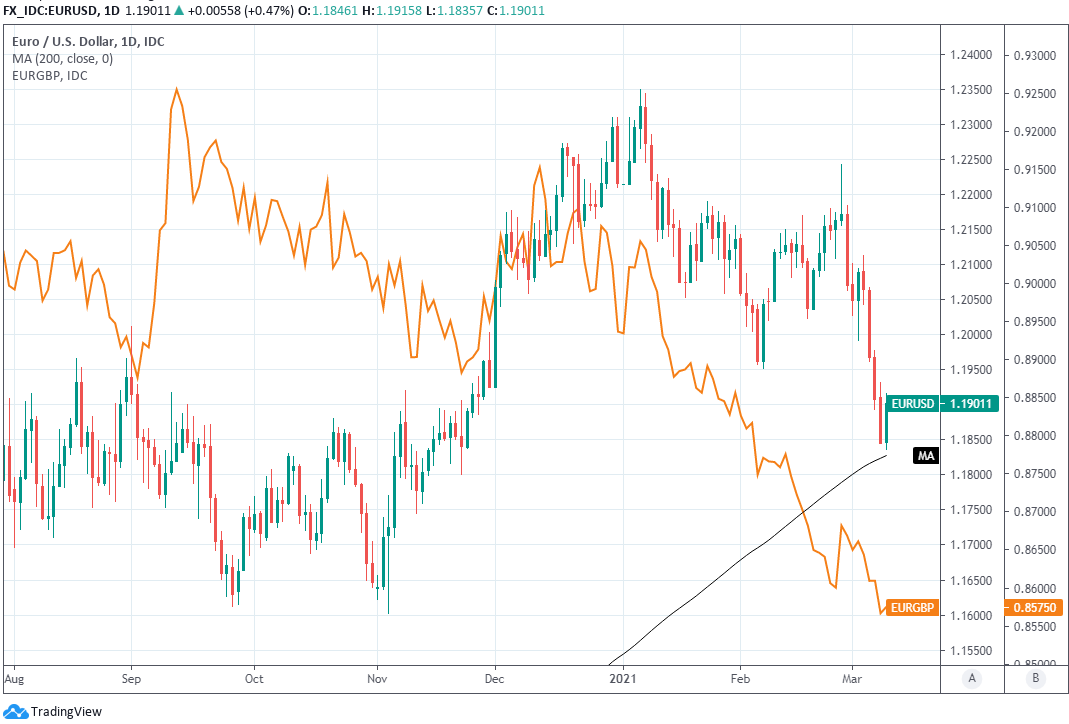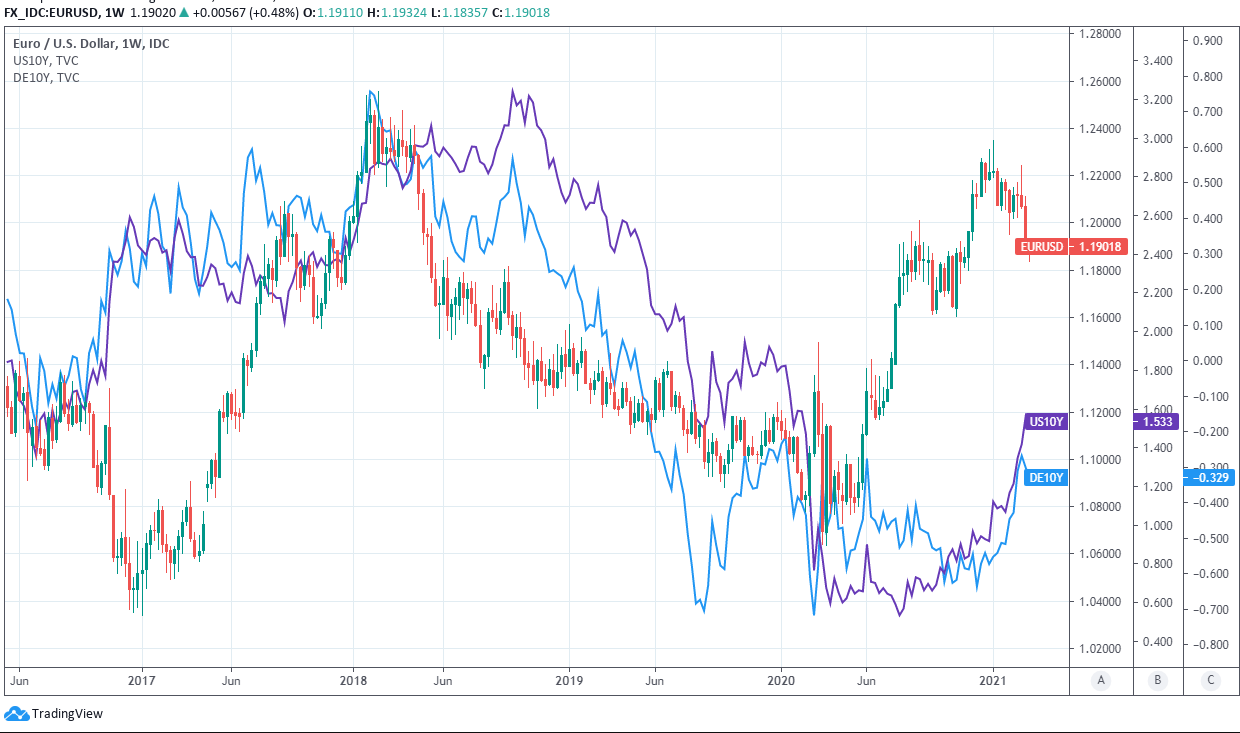Euro-Dollar Seen Finding Feet ahead of Summer 2021 Recovery
- Written by: James Skinner
-

© Grecaud Paul, Adobe Stock
- EUR/USD spot rate at time of writing: 1.1901
- Bank transfer rate (indicative guide): 1.1480-1.1560
- FX specialist providers (indicative guide): 1.1725-1.1812
- More information on FX specialist rates here
The Euro-to-Dollar rate attempted to reclaim 1.19 on Tuesday as the Dollar and U.S. bond yields beat a hasty retreat from recent highs, although forecasts suggest a resumption of the single currency's earlier rally may be more of a story for the second quarter than the March month.
Europe's unified unit was one of the sell-off in U.S. and global bonds having given up the 1.20 handle before falling beneath 1.19 in Monday trade after Destatis data suggested that German industrial production contracted more than economists anticipated in the New Year.
But it stopped short of its 200-day moving-average just above 1.18 on Monday and caught a bid during Tuesday's European morning session as the 10-year U.S. bond yield charted a course for its first decline in five days, which may have played a role in bringing about widespread losses for the Dollar.
"Euro area Q4 GDP was revised down by 10bp to -0.7% q/q, with virus-driven private consumption weakness only partly offset by restocking and fixed investment. Across sectors, industry posted another strong quarter while services contracted. As economies remain under severe restrictions, we forecast -1.5% q/q growth in Q1," says Mark Cus Babic, an economist at Barclays, referring to final quarter GDP data released by Eurostat on Tuesday.
The single currency was unfazed Tuesday by official word of a final quarter economic contraction that was modestly deeper than economists expected, with the decline in U.S. bond yields and deflating of the safe-haven Dollar dominating as a driver of low-yielding currencies.
Above: Euro-to-Dollar rate shown at daily intervals with EUR/GBP (orange) and 200-day moving-average (black).
Expectations for a 2021 global economic recovery were bolstered in recent weeks by agreement in Washington on another U.S. stimulus package that is expected to receive President Joe Biden's signature this week and likely played a role in the now-abating market rout.
Rising debt issuance due to the stimulus package a with a range of other factors including the inflationary impact of damage done to the productive capacity of some industries by coronavirus-related restrictions has had investors fearing that inflation could soon make a comeback.
"There is nothing *structural* here to support sustainable wage inflation (and hence sustainable inflation)," says Michael Every, a global strategist at Rabobank. "However, a combination of base effects, US fiscal policy, and commodity price spikes mean higher headline inflation near term. That is going to continue to see markets --wrongly-- push longer bond yields higher."
This and the unprecedented new money already washing around in markets as a result of the pandemic are among drivers of the violent bond sell-off that had knock-on effects in many other parts of the world including Europe.
Falling bond prices and surging yields toppled stock and commodity markets through month-end and into March, leading to profit-taking by investors' on earlier wagers against the Dollar and in favour of other currencies, which had a particularly evident effect on low yielders like the Euro.
Above: Euro-to-Dollar rate shown at weekly intervals with U.S. 10-yr bond yield (purple) and German 10-yr yield (blue).
"The EUR correction, predicated in part by an unwind in leveraged positions, has run out of momentum ahead of the 200Day MAV at 1.1829. The EUR/USD reversal in comes amidst a moderation in UST-Bund spreads," says Jeremy Stretch, head of FX strategy at CIBC Capital Markets.
EUR/USD rose 10% in the year to early January before European Central Bank (ECB) complaints about the trade-weighted Euro (TWI) curtailed the move around 1.2350, although since then the TWI has fallen by nearly -2%.
The ECB feared that too fast a cheapening of import costs would undermine the pursuit of its ever-elusive "close to, but below 2%" inflation target, although it's likely to place greater emphasis on bond markets in this Thursday's 12:45 policy decision and 13:30 press conference.
"The ECB is under pressure to do more than simply maintain its policy stance and stress it is always ready to act. Otherwise it may risk coming across hawkish, or not dovish enough," says Florian Hense, an economist at Berenberg. "If the ECB falls well short of expectations this week, financing conditions will tighten. While the US economy is in a position to deal with higher real yields, the Eurozone economy is in a different situation"
Some economists have suggested the bank could commit to buying larger amounts in the event that global volatility lifts government financing costs too far or too fast, although it's not clear what effect this would have on the Euro given its varying responses to ECB actions that squash yields.
Source: ING Group.
Yields are the returns most often earned by investors who buy different currencies, which are generally positively correlated with those yields, although high levels of indebtedness in Europe and market concerns about debt sustainability have meant that when the ECB weighs on government borrowing costs the Euro sometimes rises.
The ECB has created €1.85 trillion of new money to fund its Pandemic Emergency Purchase Programme (PEPP), the banner under which it buys bonds to lower financing costs and help Eurozone economies through the pandemic. Meanwhile, interest rates have remained at record lows and other cheap cash has been made available through targeted-longer-term-refinancing-operations (TLTROs).
This, the EU's €750bn recovery fund and monies coughed up by national governments all make for a sizeable Eurozone economic crutch, although the growth rebound isn't expected to begin in earnest until at least the next quarter due mainly to a slow vaccine rollout on the continent.
"The current more pronounced undervaluation should help EUR/USD to defend the 200-day moving average," says Chris Turner, regional head of research at ING, who forecasts EUR/USD at 1.25 in June and 1.28 by September. "We regard the current dollar rally as a bear market bounce and remain fully invested in a 2Q story of a broadening global recovery, which should lift all currencies – including the EUR. A corrective dip in EUR/USD to 1.17/18 should still be followed by a recovery to 1.25 this summer."








